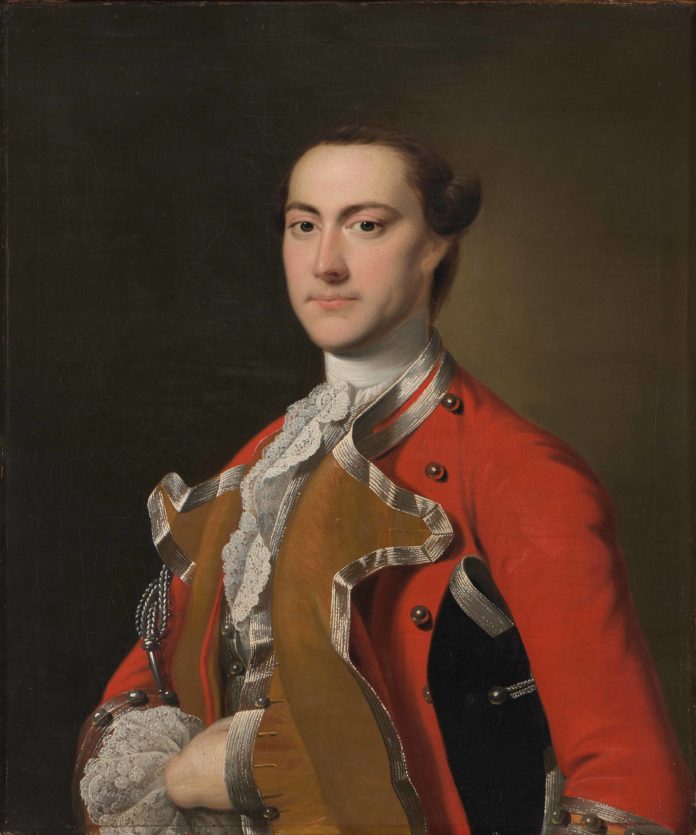
The Colonial Williamsburg Foundation has recently acquired its first portrait by the well-known eighteenth-century British landscape and portrait painter Joseph Wright of Derby (1734–1797). Equally compelling is its subject matter, as it is rare to be able to show the faces of those who were involved in events that led to the American Revolution and especially those who spent time in the Williamsburg area. Captain Richard Bayly (d. 1764), an Irishman who served in America with the 44th Regiment during the French and Indian War, sat for this portrait circa 1760 after his return to Britain, in the uniform he wore in America.
From the museum:
“The faces of early America’s military officers are largely lost to time,” said Ghislain d’Humières, Colonial Williamsburg’s executive director and senior vice president, core operations. “At Colonial Williamsburg, we are proud to be able to include their likenesses within our paintings collections and humanize their stories for our visitors in an accessible, visual manner.”
Acquiring the Bayly portrait within months after the portrait of Major Patrick Campbell (a Scottish officer who served in the British lines at the Siege of Yorktown) came into the Colonial Williamsburg collection presented an exciting opportunity to the curators there. To be able to show the people behind the series of events that led to the Revolution and to better tell the story of the French and Indian War is compelling to further the Foundation’s mission of authentically telling America’s enduring history.
Laura Pass Barry, the Juli Grainger curator of paintings, drawings, and sculpture, added, “We have an extraordinary opportunity to visually bookend the two most important events in early American military history — the French and Indian War and the Revolutionary War — with this painting and the Campbell portrait and tell a very full and personal story of the acts that transpired on American soil.”
According to Erik Goldstein, senior curator of mechanical arts and numismatics, Richard Bayly was commissioned a lieutenant in the 35th Regiment in October 1745, and transferred to the 44th Regiment in April 1750. He sailed from Cork with that regiment to America in January 1755 and disembarked at Hampton, Virginia, in late February 1755, where he spent a few weeks between Hampton and Williamsburg, likely preparing his men for war. In the famed “Braddock’s Defeat,” fought outside of today’s Pittsburgh on July 9, 1755, Bayly’s regiment suffered severely, with seven officers killed and nine wounded. Bayly and George Washington were among the few unwounded Anglo-American officers who fought in the disastrous event. Bayly was promoted to captain of the 44th Regiment in July 1757 and served in American until late 1760. When he returned to the British Isles, he sat for this portrait by Joseph Wright of Derby. To commemorate his North American service, he chose to wear his silver-laced “red coat” uniform of the 44th Regiment with its dark yellow lapels, cuffs, and waistcoat. A beautiful silver shoulder knot, called an aiguillette, hangs from his right shoulder, and his cocked hat is tucked under his left arm.
The painting was owned by the subject’s sister and inscribed as such on the reverse of the stretcher: “B. Bayly Jan.r Picture of her/Brother Richard Bayly Oct.r 1764.”
While the subject matter and his American service initially attracted the attention of the Colonial Williamsburg curators, the added incentive to acquire the painting was that it was well-documented by a noteworthy and significant painter. The artist’s account book lists a “Capt. Bailey. £6. 6s” among sitters at Derby circa 1760. Despite the misspelling of the subject’s surname, the curators at Colonial Williamsburg believe it is highly likely this is the same person given Bayly’s promotion to the rank of captain in 1757. Bayly held that rank in the 44th Foot when he returned home to Britain. He became major of the 108th regiment about a year later and served with that unit until his death in 1764.
Wright of Derby is best known for a series of works of industrial and scientific subjects. Today he is celebrated as one of the most accomplished British artists of the eighteenth century. This portrait was made relatively early in the artist’s career during a short period of time that he spent in the Midlands, several years after his training in London with the celebrated portraitist Thomas Hudson. Wright of Derby later gained a reputation for his nocturnal works experimenting with unusual lighting effects and also his portrayal of contemporary scientific subjects, canvases of which he exhibited and made available to a wider audience by employing engravers to reproduce.
The portrait was purchased through the generosity of the Friends of Colonial Williamsburg Collection Funds.
Sign up to receive Fine Art Today, the free weekly e-newsletter from
Fine Art Connoisseur magazine.







